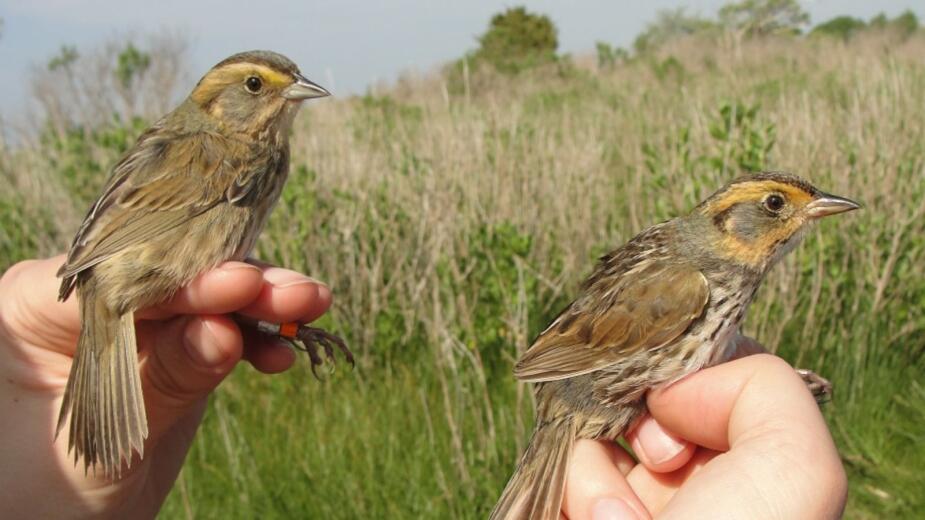Saltmarsh Sparrow (right) and Nelson’s Sparrow (left). (Photo courtesy of University of Connecticut biologist Chris Elphick.)
Metal culverts at Barn Island Wildlife Management Area in Stonington allow water to flow in and out of the salt marsh. (Photo by Nolan Addis, University of Connecticut)
Metal culverts at Barn Island Wildlife Management Area in Stonington allow water to flow in and out of the salt marsh. (Photo by Nolan Addis, University of Connecticut)
Salt marshes at Barn Island Wildlife Management Area in Stonington. (Photo by Nolan Addis, University of Connecticut)
Editor’s note: This story was reported by students in UConn’s environmental journalism class, led by professor Christine Woodside, an environmental writer and former Daily Journal reporter/editor. Students who contributed to this story were Nolan Adis, Sonia Ahmed, Rebeca Marin, Emily Macron Markelon, Deanna Martin, Erica Yirenkyi and Anna Zimmermann.

In southeastern Connecticut’s coastal marshes, a brownish-brown bird that lives only in salt marshes is fighting for survival as rising sea levels bring more frequent flooding.
Since 1998, the saltmarsh sparrow (Ammospiza caudacuta) population in the United States has declined by approximately 87%. In 2012, their number was approximately 60,000. Today, about 20,000 breed in East Coast marshes.
Sea levels across the sparrow’s range are projected to rise about 13 inches by 2050 above the 1994-2014 baseline, according to the latest estimates provided to NASA by the Intergovernmental Panel on Climate Change.
Coastal salt marshes are grassy wetlands that are regularly flooded by saltwater from the Atlantic coast, about once a month in the past. Now, the floods are higher and more frequent than once a month.
Saltmarsh sparrows begin breeding around the new moon in early May. They lay their eggs in swamp grass, betting that the eggs will hatch before the next flood. Their eggs may be washed away and the chicks may drown before they are old enough to fly.
The struggles of the saltmarsh sparrow are evidence that the marshes that serve as buffers between water and land are changing. Salt marshes have many important features, from the mineral-laden sediments beneath them to the plants that are unique to their environment.
Normally, marshes migrate inland as sea levels rise, but in many areas today they can’t because buildings, streets and railroad tracks block the way.
The Fish and Wildlife Service will decide this year whether to add the saltmarsh sparrow to the federal endangered species list. In Connecticut, they are listed as a species of special concern.
They breed in coastal states from southern Maine to Virginia and winter in southern Florida. A coalition of regional scientists is working to stabilize its population.
The drama of a species’ struggle plays out in the vast marshlands of Stonington’s Barn Island Wildlife Management Area. Chris Elphick, a conservation biologist and professor at the University of Connecticut, has been studying the bird’s decline there since 2002.
He began these studies after hearing from conservationists in the town of Guilford, who observed saltmarsh sparrow nests being flooded there.
Elphick said saltmarsh sparrows are struggling as the Atlantic Coast marshes change, but in Connecticut, things are already bad.
Flooding and rates of change are most dramatic here.
The chaotic life of a saltmarsh sparrow
In many ways, saltmarsh sparrows already live chaotic lives. Males and females mate with multiple partners, which is unusual among birds. During periods of saltwater flooding, females build nests in marsh grass. It is hoped that before the tide returns, the eggs will hatch and the chicks will gain some strength. Saltmarsh sparrows have shown signs of adaptation, from rebuilding nests to recollecting eggs that have left the nest.
Elphick published a study in November 2023 with colleague Christopher R. Field of the University of Connecticut and a group of scientists from various institutions in the Northeast, including the Cornell University Laboratory of Ornithology. They tend to be small, concentrated, and difficult to recover from disruptions. Scientists found that development isolated populations of these birds, affecting their ability to maintain genetic diversity. Restoring marshes by improving water flow in and out of marshes is critical to the birds’ survival, they wrote.
Elphick said saltmarsh sparrows are one of the first species to be affected by climate change: seawater rising directly into their homes. Therefore, understanding their struggles can help humans understand how climate change is changing the landscape.
Human changes to swamps
Barn Island is a 1,024-acre salt marsh that humans have been modifying for nearly a century. The state of Connecticut purchased much of this land in the 1940s to provide healthy, undisturbed habitat for fish, birds, mammals and other wildlife. The area includes coastal forests, salt marshes, and the open water of Little Narragansett Bay.
Over centuries, humans have modified salt marshes. From housing to transportation to digging mosquito-proof trenches to harvesting saltmarsh hay, these practices harm the health of the moorland.
The Town of Stonington dug ditches in 1931 to drain water and control mosquitoes. They soon realized this would affect waterbirds that needed the insects. In the 1940s, state Fish and Game officials purchased adjoining land and built a dike that flooded the reservoir. This helps waterfowl but changes the salt content in the water. As a result, the growth of invasive grasses like tall reeds and cattails has led to the loss of some habitat for saltmarsh sparrows that need tall grass.
Managers then installed large culverts under the levees to restore saltwater inflow and outflow to the marsh grasses, which helped promote salt marsh grass (Spartina alterniflora), salt meadow grass (Spartina patens) and spike grass (Distichlis spicata). ) and other native grass growth.
A path across Barn Island follows the dyke that separates the high marshes from the vast cisterns. These man-made structures form a vast grid within the marsh, outlining large areas of Spartina alterniflora that intersect with waterways that flow within these entrenched boundaries. These plants provide nesting, shelter, and seeds for birds.
Since colonial times, more than one-third of Connecticut’s tidal wetlands have been lost to development. Saltmarsh sparrow populations have declined significantly between the 1990s and 2012. recover from.
Elphick supervises graduate students in field work and monitoring. During the breeding season, they tag the birds with unique numbers, take blood samples, take measurements, and record the location of nests and vegetation.
Just as Elphick is unsure about the future of the saltmarsh sparrow, he also has doubts about the future of conservation. “I tend to be pessimistic,” he said, but that’s just my personality.
He added that the main problem is not climate change. its human development. We are building up their habitats, and when combined with other factors, climate change becomes even more severe.
A regional effort to improve saltmarsh habitat for the saltmarsh sparrow is underway. The Atlantic Coast Joint Venture was established in 1987 to restore native bird populations and in 2016 shifted its focus to saltmarsh sparrows and marshes. In case of bog improvements the population dropped to an estimated 10,000.
We talk about saltmarsh sparrows because they are particularly vulnerable to rising sea levels, said Mitch Hartley, assistant North Atlantic coordinator for the Atlantic Coast Ventures. He said the shift toward salt marsh protection was because there wasn’t enough coordination in the space, and these are some of the most endangered species that live in these salt marshes.
“We’re telling the stories of thousands of people through one person’s story,” Hartley said.
Atlantic Coast Joint Venture and its partners have protected and restored more than one million acres of land. Their work on the salt marsh includes undoing damage to old mosquito ditches, raising the height of the marsh, working to move some of the marsh inland, and digging shallow micro-ditches to manage water flow.
Hartley added, “Our role is modest, but I look at a project like this and I think my grandchildren are going to be in that swamp and they probably wouldn’t be able to do it without his work,” Hartley added. Hartley said.
Aimee Weldon, a USFWS staff member in Hadley, Mass., who coordinates the Atlantic Coast joint venture, said in a recent public speech that the enterprise is 100 percent responsible for protecting the species. Global Responsibility.
She added that we really have to choose our conservation priorities very strategically so that we can really have a measurable impact on the conservation needle moving certain things forward.
#birds #troubles #reveal #story #rising #sea #levels #salt #marshes
Image Source : www.theday.com



